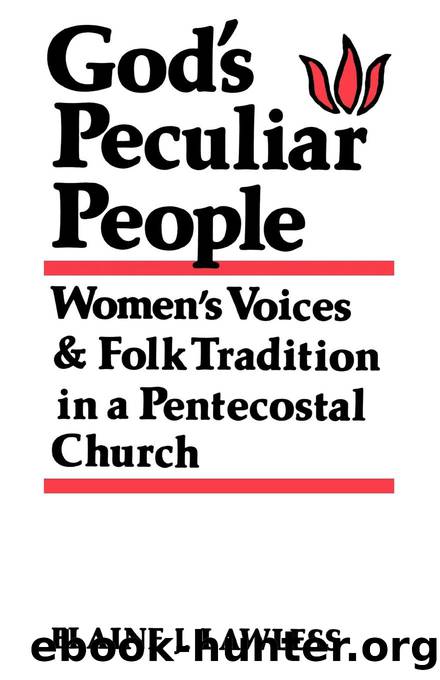God's Peculiar People by Unknown

Author:Unknown
Language: eng
Format: epub
Publisher: University Press of Kentucky
Published: 2021-08-15T00:00:00+00:00
During the group singing all members are expected to sing loudly and with enthusiasm. The evaluators of how successfully the song has been executed are often the song leader and the pastor, who may chastise the congregation for not singing in a manner proper for the exaltation of the Lord. The singing, then, is a performance meant to communicate the interest, enthusiasm, and sincerity of the congregation. All persons in attendance, of course, form the audience for the performance.
The prayer service is the only segment of the Pentecostal religious service not subject to evaluation by a critical audience. In other Protestant churches, a well-respected member may rise to lead in prayer and deliver an extemporaneous prayer that could be evaluated by the congregation; but Pentecostals all pray individually, aloud. No one prayer can be differentiated from any of the others. Careful attention to tape-recordings of prayer services reveals that some prayers are long, extemporaneous petitions to God, while others may be only slow, moaning formulaic discharges (âOhhhhh, God,â âThank you, Jesus,â âPraise the Lord.â). There is no pressure by the pastor for all to pray, or to pray loudly, or even to kneel in a certain manner. Most members kneel at their pews, but others may merely place head in hand or lean with lowered head on the back of the pew in front. Although prayer requests are taken, there is no requirement that individual prayers must include those requests. The prayer service could not, therefore, be considered a performance.
On the other hand, the testifying and the preaching can both be considered verbal communication subject to evaluation by an audience for communication competence, and both can be considered performance. They are, in fact, surprisingly similar in ways that are beneficial for an analysis of womenâs testimonies. Each is executed by one speaker and evaluated by the audience with verbal responses that indicate audience approval of both the style of execution and the content of the message. Furthermore, a well-executed testimony or sermon may trigger verbal and kinesic behaviors that attest to the successful delivery of a verbal message.
In the case of the altar call, which is the final extension of the sermon, the verbal communication of the sermon proper is abandoned for intense, short promptings intended to create an atmosphere in which participants are able to shed their inhibitions and âlet go.â The pastorâs promptings are accompanied by several important proxemic and kinesic messages that may become more significant than the verbal message. And here the audience evaluation is almost entirely expressed in audience behavior. Verbal evaluations come later in the form of âYou shouldâve been here last night. It was really great. Brother Jones had everybody dancing and speaking [in tongues].â
In order to ascertain more clearly the intricacies of a church service at Johnsonâs Creek, it is necessary to discern which of the acts of speaking are appropriate within which of the structural frames, and what proxemic and kinesic rules accompany them. Table 4 outlines the intersections of the structure of a religious service, differentiating between audience and performance roles.
Download
This site does not store any files on its server. We only index and link to content provided by other sites. Please contact the content providers to delete copyright contents if any and email us, we'll remove relevant links or contents immediately.
Men In Love by Nancy Friday(5202)
Everything Happens for a Reason by Kate Bowler(4704)
The Immortal Life of Henrietta Lacks by Rebecca Skloot(4552)
Why We Sleep by Matthew Walker(4395)
The Sports Rules Book by Human Kinetics(4348)
Not a Diet Book by James Smith(3380)
The Emperor of All Maladies: A Biography of Cancer by Siddhartha Mukherjee(3114)
Sapiens and Homo Deus by Yuval Noah Harari(3033)
Day by Elie Wiesel(2752)
Angels in America by Tony Kushner(2624)
A Burst of Light by Audre Lorde(2573)
Endless Forms Most Beautiful by Sean B. Carroll(2447)
Hashimoto's Protocol by Izabella Wentz PharmD(2352)
Dirty Genes by Ben Lynch(2296)
Reservoir 13 by Jon McGregor(2267)
Wonder by R J Palacio(2184)
And the Band Played On by Randy Shilts(2169)
The Immune System Recovery Plan by Susan Blum(2042)
Stretching to Stay Young by Jessica Matthews(2014)
